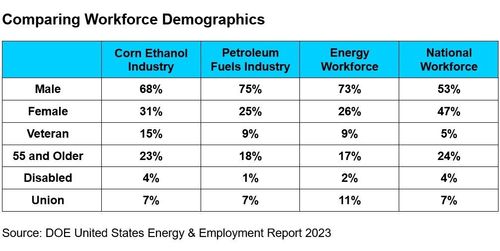Ethanol industry leads the charge in hiring military veterans

SOURCE: Renewable Fuels Association
June 28, 2023
BY Renewable Fuels Association
The U.S. corn ethanol industry continues to be a leader when it comes to employing military veterans, a new study released today by the U.S. Department of Energy reports. The veteran workforce in the ethanol industry is triple the rate seen in the national workforce average and higher than the petroleum fuels and general energy workforce.
“This report shows how, once again, the U.S. ethanol industry proudly leads the way in hiring military veterans,” said RFA President and CEO Geoff Cooper, himself an Army veteran and part of the RFA staff’s 20 percent veteran workforce. “The ethanol industry’s values and priorities, focused on American-made products that provide energy independence, align extremely well with those of our women and men in uniform, so it’s no surprise that we are attractive to veterans seeking employment. Military veterans know that they can continue to protect their fellow Americans and serve their country by producing a homegrown, cleaner, greener, and more affordable renewable fuel.”
Advertisement
Advertisement
Veterans made up 15 percent of the corn ethanol fuels workforce, which is a higher concentration than the 9 percent energy workforce average, according to the report, which was prepared by DOE’s Office of Energy Jobs. The petroleum fuels workforce is 9 percent veteran. Meanwhile, ethanol industry workers represented by a union or labor agreement make up 7 percent of the industry workforce, the same as the national workforce average and identical to that of the petroleum fuels sector, according to the report.
Cooper also noted that the DOE report underscores that progress is being made toward the industry goals of greater diversity. Females account for 31 percent of the ethanol industry workforce, well above the 26 percent average across all energy sectors. The petroleum fuels workforce, by contrast, is 25 percent female. The ethanol industry also hires more older workers, with 23 percent of its workforce aged 55 or older, compared to 18 percent for the petroleum fuels industry and 17 percent across the energy sector.
Advertisement
Advertisement
The portion of the ethanol industry workforce made up of Hispanic or Latino workers has grown from 9 percent in 2018 to 11 percent in 2022, while the share comprised of Native Hawaiian or other Pacific Islander workers has doubled from 1 percent to 2 percent. The shares of workers identifying as Black or African American has grown by two percentage points since last year, from 5 percent to 7 percent, and American Indian or Alaska Native (1 percent), Asian (6 percent), Black or African American (5 percent), and two or more races (5 percent) have held relatively steady.
Workers with disabilities comprise 4 percent of the ethanol industry workforce, double the average across all energy sectors and on par with the national average.
Related Stories
Neste Corp. on July 24 released second quarter results, reporting record quarterly renewable product sales volumes despite weaker margins. SAF sales were up nearly 80% when compared to the first quarter of 2025.
Valero Energy Corp. on July 24 released second quarter results, reporting a profitable three-month period for its ethanol segment. The renewable diesel segment posted a loss, but the company’s new sustainable aviation fuel (SAF) unit operated well.
The IRS on July 21 published a notice announcing the 2025 calendar-year inflation adjustment factor for the Section 45Z clen fuel production credit. The resulting adjustment boosts maximum the value of the credit by approximately 6%.
U.S. Secretary of Agriculture Brooke L. Rollins today announced the reorganization of the USDA, refocusing its core operations to better align with its founding mission of supporting American farming, ranching, and forestry.
The U.S. Department of Energy’s Office of Energy Efficiency and Renewable Energy is soliciting public comments on a preliminary plan for determining provisional emissions rates (PER) for the purposes of the 45Z clean fuel production credit.
Upcoming Events










